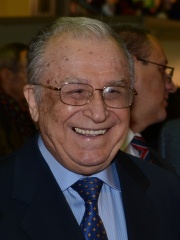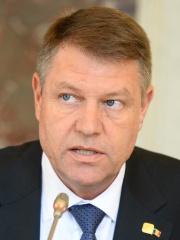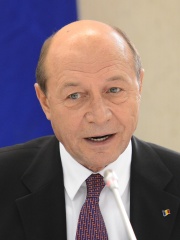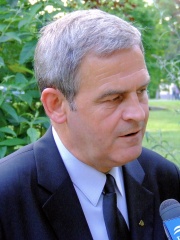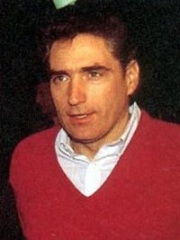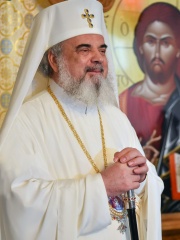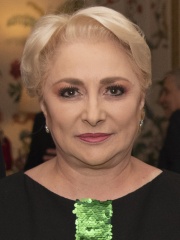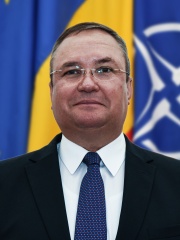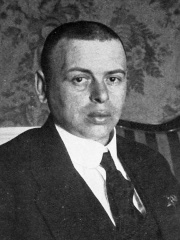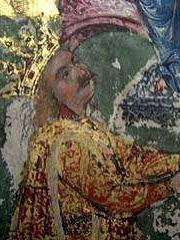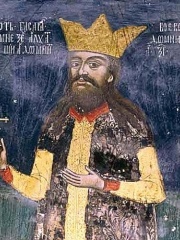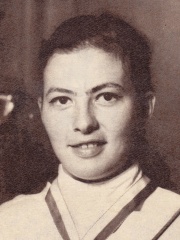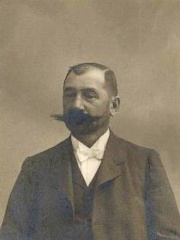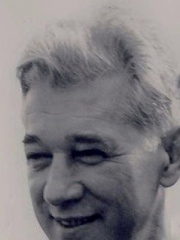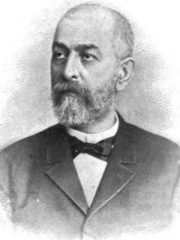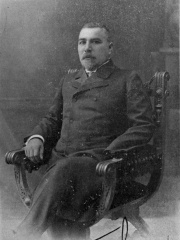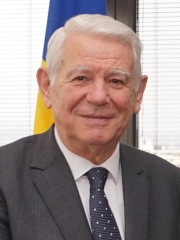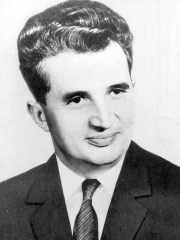

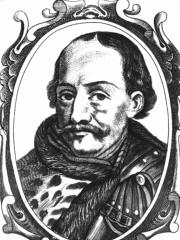
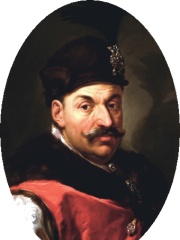
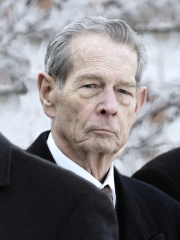
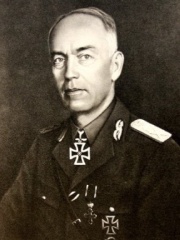
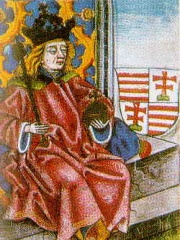
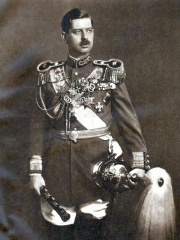
The Most Famous
POLITICIANS from Romania
This page contains a list of the greatest Romanian Politicians. The pantheon dataset contains 15,577 Politicians, 153 of which were born in Romania. This makes Romania the birth place of the 21st most number of Politicians behind Sweden and Denmark.
Top 10
The following people are considered by Pantheon to be the top 10 most legendary Romanian Politicians of all time. This list of famous Romanian Politicians is sorted by HPI (Historical Popularity Index), a metric that aggregates information on a biography’s online popularity. Visit the rankings page to view the entire list of Romanian Politicians.

1. Nicolae Ceaușescu (1918 - 1989)
With an HPI of 82.35, Nicolae Ceaușescu is the most famous Romanian Politician. His biography has been translated into 91 different languages on wikipedia.
Nicolae Ceaușescu ( chow-SHESK-oo, Romanian: [nikoˈla.e tʃe̯a.uˈʃesku] , 26 January [O.S. 13 January] 1918 – 25 December 1989) was a Romanian communist politician and statesman. He was the general secretary of the Romanian Communist Party from 1965 to 1989, and the second and last communist leader of Romania. He was also the country's head of state from 1967 to 1989, and widely classified as a dictator, serving as President of the State Council and from 1974 concurrently as President of the Republic, until his overthrow and execution in the Romanian Revolution in December 1989, part of a series of anti-communist uprisings in Eastern Europe that year. Born in 1918 in Scornicești, Ceaușescu was a member of the Romanian Communist youth movement. He was arrested in 1939 and sentenced for "conspiracy against social order", spending the time during the war in prisons and internment camps: Jilava (1940), Caransebeș (1942), Văcărești (1943), and Târgu Jiu (1943). Ceaușescu rose up through the ranks of Gheorghe Gheorghiu-Dej's Socialist government and, upon Gheorghiu-Dej's death in 1965, he succeeded to the leadership of the Romanian Communist Party as general secretary. Upon achieving power, he eased press censorship and condemned the Warsaw Pact invasion of Czechoslovakia in his speech of 21 August 1968, which resulted in a surge in popularity. However, this period of stability was brief, as his government soon became totalitarian and came to be considered the most repressive in the Eastern Bloc. His secret police, the Securitate, was responsible for mass surveillance as well as severe repression and human rights abuses within the country, and controlled the media and press. Ceaușescu's attempts to implement policies that would lead to a significant growth of the population led to a growing number of illegal abortions and increased the number of orphans in state institutions. Economic mismanagement due to failed oil ventures during the 1970s led to very significant foreign debts for Romania. In 1982, Ceaușescu directed the government to export much of the country's agricultural and industrial production in an effort to repay these debts. His cult of personality experienced unprecedented elevation, followed by the deterioration of foreign relations, even with the Soviet Union. As anti-government protesters demonstrated in Timișoara in December 1989, he perceived the demonstrations as a political threat and ordered military forces to open fire on 17 December, causing many deaths and injuries. The revelation that Ceaușescu was responsible resulted in a massive spread of rioting and civil unrest across the country. The demonstrations, which reached Bucharest, became known as the Romanian Revolution—the only violent overthrow of a communist government in the course of the Revolutions of 1989. Ceaușescu and his wife Elena fled the capital in a helicopter, but they were captured by the military after the armed forces defected. After being tried and convicted of economic sabotage and genocide, both were sentenced to death, and they were immediately executed by firing squad on 25 December.

2. Alaric I (376 - 410)
With an HPI of 74.88, Alaric I is the 2nd most famous Romanian Politician. His biography has been translated into 71 different languages.
Alaric I (; Gothic: 𐌰𐌻𐌰𐍂𐌴𐌹𐌺𐍃, Alarīks, "ruler of all"; c. 370 – 411 AD) was the first king of the Visigoths, from 395 to 410. He rose to leadership of the Goths who came to occupy Moesia—territory acquired a couple of decades earlier by a combined force of Goths and Alans after the Battle of Adrianople. Alaric began his career under the Gothic soldier Gainas and later joined the Roman army. Once an ally of Rome under the Roman emperor Theodosius, Alaric helped defeat the Franks and other allies of a would-be Roman usurper. Despite losing many thousands of his men, he received little recognition from Rome and left the Roman army disappointed. After the death of Theodosius and the disintegration of the Roman armies in 395, he is described as king of the Visigoths. As the leader of the only effective field force remaining in the Balkans, he sought Roman legitimacy, never quite achieving a position acceptable to himself or to the Roman authorities. He operated mainly against the successive Western Roman regimes, and marched into Italy, where he died. He is responsible for the sack of Rome in 410; one of several notable events in the Western Roman Empire's eventual decline.

3. John Hunyadi (1407 - 1456)
With an HPI of 72.95, John Hunyadi is the 3rd most famous Romanian Politician. His biography has been translated into 42 different languages.
John Hunyadi (Hungarian: Hunyadi János; Romanian: Ioan de Hunedoara; Croatian: Janko Hunjadi; Serbian: Сибињанин Јанко, romanized: Sibinjanin Janko; c. 1406 – 11 August 1456) was a leading Hungarian military and political figure in the Kingdom of Hungary during the 15th century. According to most contemporary sources, he was the member of a noble family of Wallachian ancestry. Through his struggles against the Ottoman Empire, he earned for himself the nickname 'Turk-buster' from his contemporaries. Due to his merits, he quickly received substantial land grants. By the time of his death, he was the owner of immense land areas, totaling approximately four million cadastral acres, which had no precedent before or after in the Kingdom of Hungary. His enormous wealth, his military and political weight were primarily directed towards the purposes of the Ottoman wars. Hunyadi mastered his military skills on the southern borderlands of the Kingdom of Hungary that were exposed to Ottoman attacks. Appointed Ban of Szörény in 1439, appointed Voivode of Transylvania, Counts of the Székelys and Chief Captain of Nándorfehérvár (now Belgrade) in 1441 and head of a several of southern counties of the Kingdom of Hungary, he assumed responsibility for the defense of the frontiers. He adopted the Hussite method of using wagons for military purposes. He employed professional soldiers, but also mobilized local peasantry against invaders. These innovations contributed to his earliest successes against the Ottoman troops who were plundering the southern marches in the early 1440s. In the year of 1442, Hunyadi won four victories against the Ottomans, two of which were decisive. In March 1442, Hunyadi defeated Mezid Bey and the raiding Ottoman army at the Battle of Szeben in the south part of the Kingdom of Hungary in Transylvania. In September 1442, Hunyadi defeated a large Ottoman army of Beylerbey Şehabeddin, the Provincial Governor of Rumelia. This was the first time that a European army defeated such a large Ottoman force, composed not only of raiders, but of the provincial cavalry led by their own sanjak beys (governors) and accompanied by the formidable janissaries. Although defeated in the battle of Varna in 1444 and in the second battle of Kosovo in 1448, his successful "Long Campaign" across the Balkan Mountains in 1443–44 and defence of Belgrade (Nándorfehérvár) in 1456, against troops led personally by the sultan, established his reputation as a great general. The pope ordered that European churches ring their bells at noon to gather the faithful in prayer for those who were fighting. The bells of Christian churches are rung at noon to commemorate the Belgrade victory. John Hunyadi was also an eminent statesman. He actively took part in the civil war between the partisans of Wladislas I and the minor Ladislaus V, two claimants to the throne of Hungary in the early 1440s, on behalf of the former. Popular among the lesser nobility, the Diet of Hungary appointed him, in 1445, as one of the seven "Captains in Chief" responsible for the administration of state affairs until Ladislaus V (by that time unanimously accepted as king) came of age. The next Diet went even further, electing Hunyadi as sole regent with the title of governor. When he resigned from this office in 1452, the sovereign awarded him with the first hereditary title (perpetual count of Beszterce/Bistrița) in the Kingdom of Hungary. He had by this time become one of the wealthiest landowners in the kingdom, and preserved his influence in the Diet up until his death. This Athleta Christi (Christ's Champion), as Pope Pius II referred to him, died some three weeks after his triumph at Belgrade, falling to an epidemic that had broken out in the crusader camp. However, his victories over the Turks prevented them from invading the Kingdom of Hungary for more than 60 years. His fame was a decisive factor in the election of his son, Matthias Corvinus, as king by the Diet of 1457. Hunyadi is a popular historical figure among Hungarians, Romanians, Serbs, Bulgarians and other nations of the region.

4. Stephen Báthory (1533 - 1586)
With an HPI of 72.74, Stephen Báthory is the 4th most famous Romanian Politician. His biography has been translated into 53 different languages.
Stephen Báthory (Hungarian: Báthory István; Polish: Stefan Batory; Lithuanian: ; 27 September 1533 – 12 December 1586) was Voivode of Transylvania (1571–1576), Prince of Transylvania (1576–1586), King of Poland and Grand Duke of Lithuania (1576–1586). The son of Stephen VIII Báthory and a member of the Hungarian Báthory noble family, Báthory was a ruler of Transylvania in the 1570s, defeating another challenger for that title, Gáspár Bekes. In 1576 Báthory became the husband of Queen Anna Jagiellon and the third elected king of Poland. He worked closely with chancellor Jan Zamoyski. The first years of his reign were focused on establishing power, defeating a fellow claimant to the throne, Maximilian II, Holy Roman Emperor, and quelling rebellions, most notably, the Danzig rebellion. He reigned only a decade, but is considered one of the most successful kings in Polish history, particularly in the military realm. His signal achievement was his victorious campaign in Livonia against Russia in the middle part of his reign, in which he repulsed a Russian invasion of Commonwealth borderlands and secured a highly favorable treaty of peace (the Peace of Jam Zapolski).
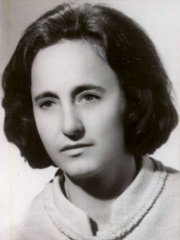
5. Elena Ceaușescu (1916 - 1989)
With an HPI of 72.09, Elena Ceaușescu is the 5th most famous Romanian Politician. Her biography has been translated into 43 different languages.
Elena Ceaușescu (Romanian pronunciation: [eˈlena tʃe̯a.uˈʃesku]; born Lenuța Petrescu; 7 January 1916 – 25 December 1989) was a Romanian communist politician who was the wife of Nicolae Ceaușescu, General Secretary of the Romanian Communist Party and leader of the Socialist Republic of Romania. She was also the Deputy Prime Minister of Romania. Following the Romanian Revolution in 1989, she was executed alongside her husband on 25 December.

6. Michael I of Romania (1921 - 2017)
With an HPI of 71.78, Michael I of Romania is the 6th most famous Romanian Politician. His biography has been translated into 52 different languages.
Michael I (Romanian: Mihai I [miˈhaj]; 25 October 1921 – 5 December 2017) was the last king of Romania, reigning from 20 July 1927 to 8 June 1930 and again from 6 September 1940 until his forced abdication on 30 December 1947. Shortly after Michael's birth, his father, Crown Prince Carol, had become involved in a controversial relationship with Magda Lupescu. In 1925, Carol was pressured to renounce his rights (in favour of his son Michael) to the throne and moved to Paris in exile with Lupescu. In 1927, following the death of his grandfather Ferdinand I, Michael ascended the throne at age five, the youngest crowned head in Europe. As Michael was still a minor, a regency council was instituted, composed of his uncle Prince Nicolas, Patriarch Miron Cristea and Chief Justice Gheorghe Buzdugan. The council proved to be ineffective and, in 1930, Carol returned to Romania and replaced his son as monarch, reigning as Carol II. As a result, Michael returned to being heir apparent to the throne and was given the additional title of Grand Voievod of Alba-Iulia. Carol II was forced to abdicate in 1940, and Michael once again became king. Under the government led by the military dictator Ion Antonescu, Romania became aligned with Nazi Germany. In 1944, Michael participated in a coup against Antonescu, appointed Constantin Sănătescu as his replacement, and subsequently declared an alliance with the Allies. In March 1945, political pressures forced Michael to appoint a pro-Soviet government headed by Petru Groza. From August 1945 to January 1946, Michael went on a "royal strike" and unsuccessfully tried to oppose Groza's communist-controlled government by refusing to sign and endorse its decrees. In November 1947, Michael attended the wedding of his cousins, the future Queen Elizabeth II of the United Kingdom and Prince Philip of Greece and Denmark in London. Shortly thereafter, on the morning of 30 December 1947, Groza met with Michael and compelled him to abdicate, while the monarchy was abolished. Michael was forced into exile, his properties confiscated, and his citizenship stripped. In 1948, he married Princess Anne of Bourbon-Parma, with whom he had five daughters. The couple eventually settled in Switzerland. Nicolae Ceaușescu's communist dictatorship was overthrown in 1989 and the following year Michael attempted to return to Romania, only to be arrested and forced to leave upon arrival. In 1992, Michael was allowed to visit Romania for Easter, where he was greeted by huge crowds; a speech he gave from his hotel window drew an estimated one million people to Bucharest. Alarmed by Michael's popularity, the post-communist government of Ion Iliescu refused to allow him any further visits. In 1997, after Iliescu's defeat by Emil Constantinescu in the presidential election of the previous year, Michael's citizenship was restored and he was allowed to visit Romania again. Several confiscated properties, such as Peleș Castle and Săvârșin Castle, were eventually returned to his family.

7. Ion Antonescu (1882 - 1946)
With an HPI of 71.56, Ion Antonescu is the 7th most famous Romanian Politician. His biography has been translated into 56 different languages.
Ion Antonescu (; Romanian: [i'on antoˈnesku] ; 14 June [O.S. 2 June] 1882 – 1 June 1946) was a Romanian military officer and marshal who presided over two successive wartime dictatorships as Prime Minister and Conducător during most of World War II. Having been responsible for facilitating the Holocaust in Romania, he was tried for war crimes and executed in 1946. A Romanian Army career officer who made his name during the 1907 peasants' revolt and the World War I Romanian campaign, the antisemitic Antonescu sympathized with the far-right and fascist National Christian and Iron Guard groups for much of the interwar period. He was a military attaché to France and later Chief of the General Staff, briefly serving as Defense Minister in the National Christian cabinet of Octavian Goga as well as the subsequent First Cristea cabinet, in which he also served as Air and Marine Minister. During the late 1930s, his political stance brought him into conflict with King Carol II and led to his detainment. Antonescu nevertheless rose to political prominence during the political crisis of 1940, and established the National Legionary State, an uneasy partnership with the Iron Guard's leader Horia Sima. After entering Romania into an alliance with Nazi Germany and ensuring Adolf Hitler's confidence, he eliminated the Guard during the Legionary Rebellion of 1941. In addition to being Prime Minister, he served as his own Foreign Minister and Defense Minister. Soon after Romania joined the Axis in Operation Barbarossa, recovering Bessarabia and Northern Bukovina, Antonescu also became Marshal of Romania. An atypical figure among Holocaust perpetrators, Antonescu enforced policies independently responsible for the deaths of as many as 400,000 people, most of them Bessarabian, Ukrainian and Romanian Jews, as well as Romanian Romani. The regime's complicity in the Holocaust combined pogroms and mass murders such as the Odessa massacre with ethnic cleansing, and systematic deportations to occupied Transnistria. The system in place was nevertheless characterized by singular inconsistencies, prioritizing plunder over killing, showing leniency toward most Jews in the Old Kingdom, and ultimately refusing to adopt the Final Solution as applied throughout German-occupied Europe. This was made possible by the fact that Romania, as a junior ally of Nazi Germany, was able to avoid being occupied by the Wehrmacht and preserve a degree of political autonomy. Aerial attacks on Romania by the Allies occurred in 1944 and Romanian troops suffered heavy casualties on the Eastern Front, prompting Antonescu to open peace negotiations with the Allies, ending with inconclusive results. On 23 August 1944, the king Michael I led a coup d'état against Antonescu, who was arrested; after the war he was convicted of war crimes, and executed in June 1946. His involvement in the Holocaust was officially reasserted and condemned following the 2003 Wiesel Commission report.

8. Béla IV of Hungary (1206 - 1270)
With an HPI of 71.25, Béla IV of Hungary is the 8th most famous Romanian Politician. His biography has been translated into 48 different languages.
Béla IV (1206 – 3 May 1270) was King of Hungary and Croatia between 1235 and 1270, and Duke of Styria from 1254 to 1258. As the oldest son of King Andrew II, he was crowned upon the initiative of a group of influential noblemen in his father's lifetime in 1214. His father, who strongly opposed Béla's coronation, refused to give him a province to rule until 1220. In this year, Béla was appointed Duke of Slavonia, also with jurisdiction in Croatia and Dalmatia. Around the same time, Béla married Maria, a daughter of Theodore I Laskaris, Emperor of Nicaea. From 1226, he governed Transylvania as duke. He supported Christian missions among the pagan Cumans who dwelled in the plains to the east of his province. Some Cuman chieftains acknowledged his suzerainty and he adopted the title of King of Cumania in 1233. King Andrew died on 21 September 1235 and Béla succeeded him. He attempted to restore royal authority, which had diminished under his father. For this purpose, he revised his predecessors' land grants and reclaimed former royal estates, causing discontent among the noblemen and the prelates. The Mongols invaded Hungary and annihilated Béla's army in the Battle of Mohi on 11 April 1241. He escaped from the battlefield, but a Mongol detachment chased him from town to town as far as Trogir on the coast of the Adriatic Sea. Although he survived the invasion, the Mongols devastated the country before their unexpected withdrawal in March 1242. Béla introduced radical reforms in order to prepare his kingdom for a second Mongol invasion. He allowed the barons and the prelates to erect stone fortresses and to set up their private armed forces. He promoted the development of fortified towns. During his reign, thousands of colonists arrived from the Holy Roman Empire, Poland and other neighboring regions to settle in the depopulated lands. Béla's efforts to rebuild his devastated country won him the epithet of "second founder of the state" (Hungarian: második honalapító). He set up a defensive alliance against the Mongols, which included Daniil Romanovich, Prince of Halych, Boleslaw the Chaste, Duke of Cracow and other Ruthenian and Polish princes. His allies supported him in occupying the Duchy of Styria in 1254, but it was lost to King Ottokar II of Bohemia six years later. During Béla's reign, a wide buffer zone—which included Bosnia, Barancs (Braničevo, Serbia) and other newly conquered regions—was established along the southern frontier of Hungary in the 1250s. Béla's relationship with his oldest son and heir, Stephen, became tense in the early 1260s, because the elderly king favored his daughter Anna and his youngest child, Béla, Duke of Slavonia. He was forced to cede the territories of the Kingdom of Hungary east of the river Danube to Stephen, which caused a civil war lasting until 1266. Nevertheless, Béla's family was famed for his piety: he died as a Franciscan tertiary, and the veneration of his three saintly daughters—Kunigunda, Yolanda, and Margaret—was confirmed by the Holy See.

9. Carol II of Romania (1893 - 1953)
With an HPI of 70.51, Carol II of Romania is the 9th most famous Romanian Politician. His biography has been translated into 45 different languages.
Carol II (15 October 1893 [O.S. 3 October 1893] – 4 April 1953) was King of Romania from June 8, 1930, until his forced abdication on September 6, 1940. As the eldest son of Ferdinand I, he became crown prince upon the death of his grand-uncle, King Carol I, in 1914. He was the first of the Hohenzollern kings of Romania to be born in the country, as both of his predecessors had been born in Germany and came to Romania only as adults. As such, he was the first member of the Romanian branch of the Hohenzollerns who spoke Romanian as his first language and was also the first member of his royal family to be raised in the Orthodox faith.Carol's life and reign were surrounded by controversy and accusations of lack of duty, due to his desertion from the army during World War I. Another controversy was his marriage to Zizi Lambrino, which resulted in two attempts by Carol to give up the rights of succession to the royal crown of Romania, both of which were refused by his father, King Ferdinand.After the dissolution of his marriage, he met Princess Helen of Greece and Denmark, daughter of King Constantine I of Greece, married her in March of 1921, and had a child in the same year, that being King Michael of Romania. But due to Carol's continued affairs with Elena Lupescu he was obliged to renounce his succession rights in 1925 and leave the country. His name was subsequently removed from the royal house of Romania by King Ferdinand I. After his removal from the Royal House, Carol moved to France with Lupescu under the name Carol Caraiman. Michael, aged 5, inherited the throne on the death of King Ferdinand in 1927. Princess Helen eventually divorced Carol in 1928. In the political crisis created by the deaths of Ferdinand I and Ion I. C. Brătianu and the ineffective regency of Prince Nicholas of Romania, Miron Cristea, and Gheorghe Buzdugan, Carol was allowed to return to Romania in 1930, and his name was restored by the royal house of Romania, dethroning his own son. The beginning of Carol’s reign was marked by the negative economic effects of the Great Depression. Carol II weakened the parliament of Romania, often appointing minority factions of historical parties to the government and attempting to form nationally concentrated governments, such as the Iorga-Argetoianu government. He also allowed for the formation of a corrupt parliament chamber around him, under the patronage of Elena Lupescu. A political crisis followed the December 1937 elections, where no party achieved an absolute majority and a coalition could not be formed because of disagreements between the National Liberal Party and the National Peasants Party and Iron Guard whom they would have needed to form a Coalition Government. Following this crisis Carol established a royal dictatorship in 1938 by removing the 1923 constitution, abolishing all political parties, and forming a new single party, the National Renaissance Front, which consisted mostly of former members of the National Peasants Party and National Christian Party who had been patronized by the king. The National Renaissance Front was the last of several attempts to counter the popularity of the fascist Iron Guard. Following the start of World War II, Carol II reaffirmed the Polish–Romanian alliance; the military assistance was, however, declined by Poland, which wished to follow the Romanian Bridgehead plan that required a neutral Romania. Following the fall of Poland and the involvement of the USSR, Carol II maintained a neutrality policy. After the fall of France, Carol II's policy changed towards re-alignment with Nazi Germany in hopes of gaining a German guarantee. He was, however, not aware of the secret clauses of the Ribbentrop-Molotov pact between Germany and the Soviet Union that would see Romania lose significant parts of its territory. The year 1940 marked the fragmentation of Greater Romania by the seceding of Bessarabia and Northern Bukovina to the USSR, Northern Transylvania to Hungary and Southern Dobruja to Bulgaria. Although a German guarantee was finally achieved, the situation had a disastrous effect on the reputation of Carol II. The reorientation of Romania's foreign policy towards Nazi Germany, however, would not prevent his regime from collapsing and he would be forced to abdicate by General Ion Antonescu, the newly appointed and Nazi-backed prime minister, who was succeeded by his son Michael. After his abdication, Carol was permitted to leave the country with a special train loaded with his personal fortunes, which he had acquired during his time as king, and an attempt on his life was made by the Iron Guard, who had fired on the train in hope of killing the former king. After World War II, Carol II wanted to return to the helm of the country and dethrone his son again but was stopped by the Western Allies. For the rest of his life, he traveled the world, finally marrying Elena Lupescu while living in Brazil in 1947. After settling in the Portuguese Riviera, Carol II at the age of 59, died peacefully in exile and his son Michael I, refused to attend his funeral out of disgust for the treatment of his mother, Princess Helen by his father.
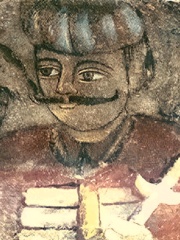
10. Vlad II Dracul (1395 - 1447)
With an HPI of 70.40, Vlad II Dracul is the 10th most famous Romanian Politician. His biography has been translated into 35 different languages.
Vlad II (Romanian: Vlad al II-lea), also known as Vlad Dracul (Vlad al II-lea Dracul) or Vlad the Dragon (before 1395 – November 1447), was Voivode of Wallachia from 1436 to 1442, and again from 1443 to 1447. He is internationally known as the father of Vlad the Impaler, or Dracula. Born an illegitimate son of Mircea I of Wallachia, he spent his youth at the court of Sigismund of Luxembourg, who made him a member of the Order of the Dragon in 1431 (hence his sobriquet). Sigismund also recognized him as the lawful Voivode of Wallachia, allowing him to settle in nearby Transylvania. Vlad could not assert his claim during the life of his half-brother, Alexander I Aldea, who acknowledged the suzerainty of the Ottoman Sultan, Murad II. After Alexander Aldea died in 1436, Vlad seized Wallachia with Hungarian support. Following the death of Sigismund of Luxembourg in 1437, Hungary's position weakened, causing Vlad to pay homage to Murad II, which included participating in Murad II's invasion of Transylvania in the summer of 1438. John Hunyadi, Voivode of Transylvania, came to Wallachia to convince Vlad to join a crusade against the Ottomans in 1441. After Hunyadi routed an Ottoman army in Transylvania, the sultan ordered Vlad to come to Edirne where he was captured in 1442. Hunyadi invaded Wallachia and made Vlad's cousin, Basarab II, voivode. Vlad was released before the end of the year but was forced to leave his two young sons as hostages in the Ottoman court. He was restored in Wallachia with Ottoman support in 1443. He remained neutral during Hunyadi's "Long Campaign" against the Ottoman Empire between October 1443 and January 1444, but he sent 4,000 horsemen to fight against the Ottomans during the Crusade of Varna. With the support of a Burgundian fleet, he captured the important Ottoman fortress at Giurgiu in 1445. He made peace with the Ottoman Empire in 1446 or 1447, which contributed to the deterioration of his relationship with Hunyadi. Hunyadi invaded Wallachia, forcing Vlad to flee from Târgoviște in late November, where he was killed at a nearby village.
Pantheon has 153 people classified as politicians born between 300 and 1984. Of these 153, 40 (26.14%) of them are still alive today. The most famous living politicians include Ion Iliescu, Klaus Iohannis, and Traian Băsescu. The most famous deceased politicians include Nicolae Ceaușescu, Alaric I, and John Hunyadi. As of April 2022, 15 new politicians have been added to Pantheon including Alexander I Aldea, Matei Basarab, and Basarab the Old.
Living Politicians
Go to all Rankings
Ion Iliescu
1930 - Present
HPI: 68.00
Klaus Iohannis
1959 - Present
HPI: 65.34
Traian Băsescu
1951 - Present
HPI: 62.07
László Tőkés
1952 - Present
HPI: 55.07
Petre Roman
1946 - Present
HPI: 55.01
Călin Popescu-Tăriceanu
1952 - Present
HPI: 50.54
Ludovic Orban
1963 - Present
HPI: 50.49
Patriarch Daniel of Romania
1951 - Present
HPI: 50.37
Viorica Dăncilă
1963 - Present
HPI: 50.16
Florin Cîțu
1972 - Present
HPI: 49.49
Nicolae Ciucă
1967 - Present
HPI: 49.21
Béla Károlyi
1942 - Present
HPI: 48.84

Deceased Politicians
Go to all Rankings
Nicolae Ceaușescu
1918 - 1989
HPI: 82.35
Alaric I
376 - 410
HPI: 74.88
John Hunyadi
1407 - 1456
HPI: 72.95
Stephen Báthory
1533 - 1586
HPI: 72.74
Elena Ceaușescu
1916 - 1989
HPI: 72.09
Michael I of Romania
1921 - 2017
HPI: 71.78
Ion Antonescu
1882 - 1946
HPI: 71.56
Béla IV of Hungary
1206 - 1270
HPI: 71.25
Carol II of Romania
1893 - 1953
HPI: 70.51
Vlad II Dracul
1395 - 1447
HPI: 70.40
Béla Kun
1886 - 1938
HPI: 69.91
Stephen III of Moldavia
1433 - 1504
HPI: 68.90

Newly Added Politicians (2022)
Go to all Rankings
Alexander I Aldea
1397 - 1436
HPI: 52.04
Matei Basarab
1580 - 1654
HPI: 51.32
Basarab the Old
HPI: 50.91
Florin Cîțu
1972 - Present
HPI: 49.49
Nicolae Ciucă
1967 - Present
HPI: 49.21
Ileana Gyulai-Drîmbă-Jenei
1946 - 2021
HPI: 48.73
László Lukács
1850 - 1932
HPI: 46.85
Corneliu Mănescu
1916 - 2000
HPI: 46.24
Petre S. Aurelian
1833 - 1909
HPI: 45.20
Dimitar Petkov
1858 - 1907
HPI: 44.52
Teodor Meleșcanu
1941 - Present
HPI: 44.06
Adina-Ioana Vălean
1968 - Present
HPI: 39.19

Which Politicians were alive at the same time? This visualization shows the lifespans of the 25 most globally memorable Politicians since 1700.

